Sansevieria is a genus of plants with about 130 species, very popular due to their striking appearance and undemanding care in most cases, being very adaptable as indoor and outdoor plants. However, the plants that we still currently call Sansevieria were recently included in the genus Dracaena, in the year 2017, so technically it is an erroneous nomenclature to continue calling them that way, but that is popularly maintained to avoid misunderstandings. Learn all about the types of Sansevieria plants in this article.
Table of Contents
Types of Sansevieria Plants
With their upright, sword-shaped leaves emerging from the soil, sansevieria plants (also known as snake plants) come in a striking array of types. From different sansevieria varieties with slender, spiky leaves to larger, more curved leaf types, snake plants showcase incredible diversity in leaf colors, shapes, textures, and overall sizes. Explore some of the most popular sansevieria types and cultivars – whether you want a low tabletop type or a tall, statement-making plant type, get acquainted with distinguishing snake plant characteristics. Learn to identify key factors like leaf and growth patterns that set popular sansevieria types apart. Understand what makes certain types of sansevieria plants unique.
Sansevieria cylindrica
This plant has its origin in the tropical zones of Africa. It is a strikingly shaped species, with 3 to 5 cylindrical-shaped leaves, about 1.2″ (3 cm) in diameter and up to 6.5 ft (2 meters) long. They are dark green, with lighter edges, and produce a floral stem of up to one meter, smaller than the leaves, but covered with striking white and pink flowers of small size. It is common to cultivate it by braiding its leaves so that they intertwine, giving rise to some certainly showy forms.
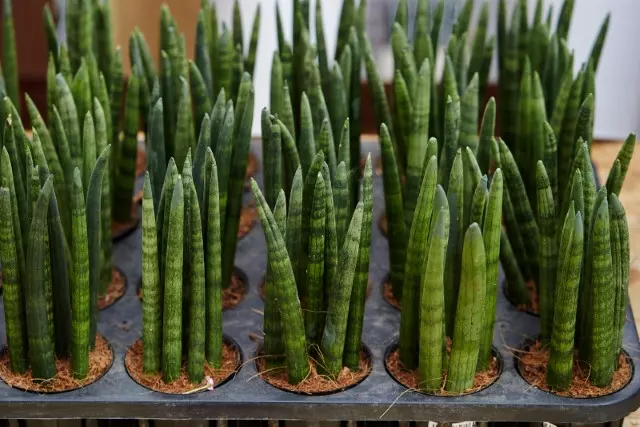
Sansevieria trifasciata
The trifasciata is the most common of all Sansevieria in terms of home cultivation. It is also known as tiger’s tongue, mother-in-law’s tongue, or snake plant among many other names, and is also native to tropical Africa.
Its characteristic leaves are variegated and grow with a marked upright growth, reaching up to one and a half meters long and 4″ (10 cm) wide. The flowers, which appear in clusters of slightly more than half the length of the leaves, are light-colored and produce small orange berries.
Among Sansevieria trifasciata itself, two widespread varieties are distinguished, Sansevieria trifasciata var Hahnii and Sansevieria trifasciata var Laurentii. The first is a variety of very small sizes, below 16″ (40 cm), with wide and short leaves and a light green tone, while the second is much larger and is distinguished by the yellow edge of its leaves and the horizontal pattern.
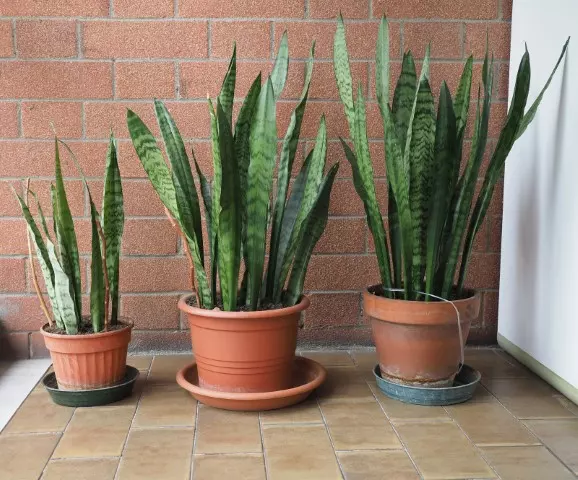
Sansevieria pinguicula
This is a species that also comes from Africa, specifically, it is a species endemic to Kenya, of small size and up to 7 or 8 green leaves, sometimes also with a horizontal pattern on them. It grows up to about 12″ (30 cm) in height, with leaves that do not exceed that length. In addition, the flowers of Sansevieria pinguicula sprout from the center of the rosette that its leaves form, in a branched panicle.
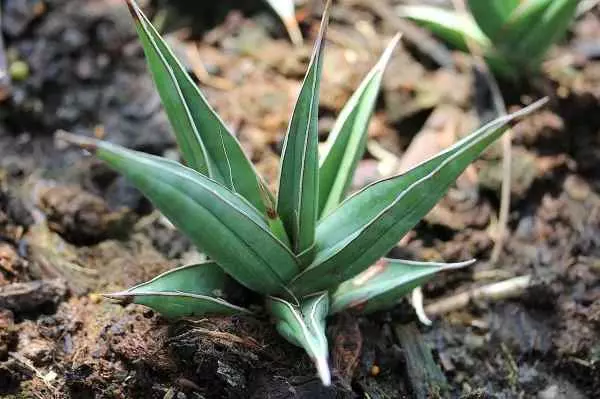
Sansevieria masoniana Victoria
The plant Sansevieria masoniana Victoria is native to North Africa. It is commonly called whale’s fin plant because it is especially striking in its appearance: it consists of a single, broad, lanceolate leaf, with the characteristic pattern that much Sansevierias display. Sansevieria masoniana does have more leaves, but the specific “Victoria” has only one, which makes it a very curious indoor plant.
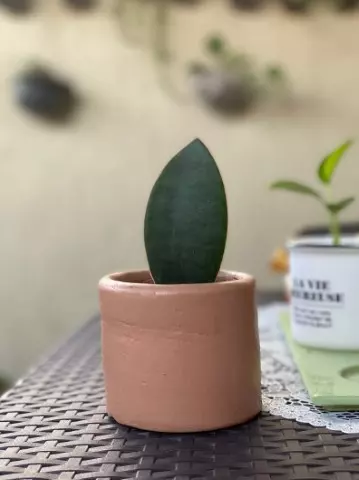
Sansevieria Zeylanica
Originating in Africa and Asia, this plant stands out for its very upright leaves, with up to 15 leaves of very light green, almost white, marked by a pattern of bright green and darker. The leaves of Sansevieria Zeylanica are up to 12″ (30 cm) long and 4″ (10 cm) wide and, in addition, this plant produces inflorescences of small white flowers, which start from the heart of the rosette of the plant.
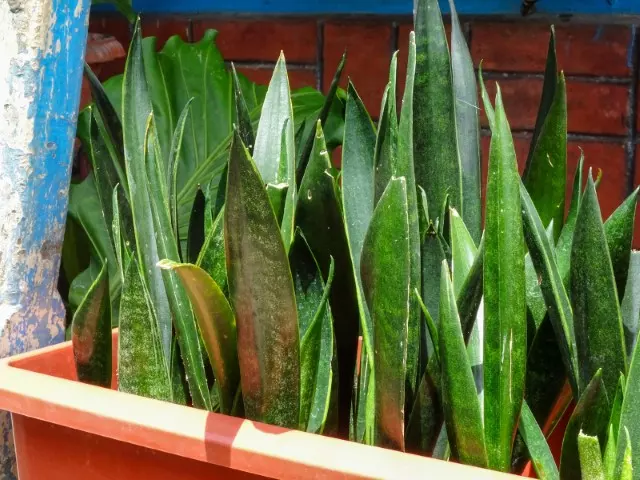
Sansevieria bacularis
Also sometimes called mikado, this plant is found naturally in southern Asia, southern Africa, and the island of Madagascar. It is one of the most particular sansevierias, with totally cylindrical leaves, very beautiful and showy, growing up to one meter high and 1.2″ (3 cm) thick. It resembles Sansevieria cylindrica in its size, although this one grows more vertically and its tone is lighter.
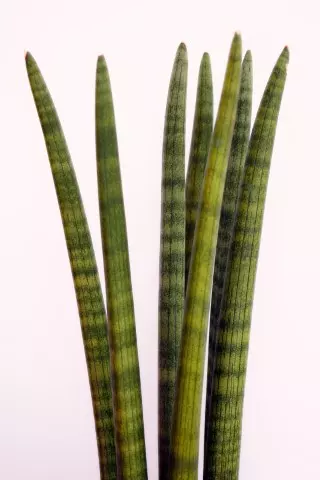
Sansevieria francisii
Sansevieria francisii, also known as African spear or snake plant, is a smaller variety of Sansevieria characterized by its compact size and cylindrical leaves. This species typically grows in tight clusters of narrow, spear-shaped foliage that can reach up to 6-8 inches (15 to 20 cm) in height. The leaves have a green-gray color with horizontal, darker green bands or mottling running along their length, giving them a distinctive appearance.
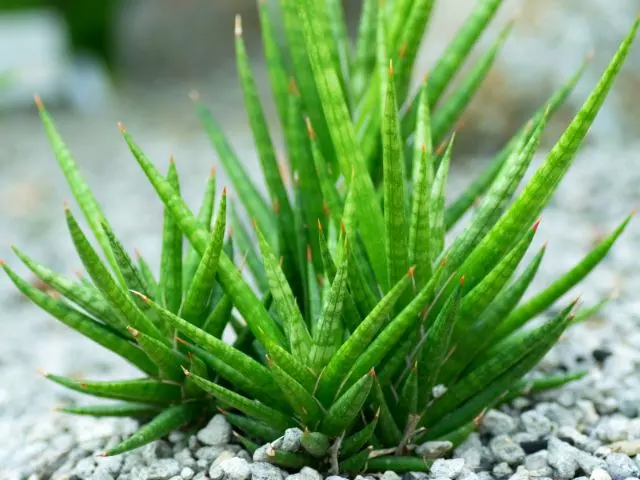
Care of Sansevieria Plants
Most species share the same general needs and preferences in their care, so it is not worth repeating them for each of the above. Instead, here we summarize their main requirements:
- Light: they need an illuminated area of semi-shade, sheltered from intense direct light. They can be grown in shade but will suffer.
- Temperature: they want a temperature of around 64 to 68°F (18 to 20 ºC). They tolerate hot, dry climates if sheltered from direct light. Some tolerate brief and light frosts.
- Watering: they do not tolerate excess humidity, which rots their roots. They should be watered sparingly, only when the substrate is completely dry. Up to twice a week in the warm months, and once a month in the cold months.
- Substrate: very light and as well drained as possible. A universal mixture rich in nutrients, with coconut fiber, worm castings, and vermiculite, will be sufficient. Learn more about the best soil for a snake plant.
- Fertilizing: every 15 days in the warm months. Specific fertilizer for green plants, or organic fertilizer applied to the base of the plant.
- Propagation: very simple both by cuttings and by rhizome division. Always use sterilized tools. I recommend you to read our guide about how to propagate a snake plant in water.
We hope this article about the types of Sansevieria will be useful.
